Toward Reducing Construction Project Delivery Time under Limited Resources
Abstract
:1. Introduction
2. Literature Review
3. Research Objectives
4. Research Methodology
- (1)
- The resource requirements of each activity during the execution process remain unchanged.
- (2)
- The overlapping period is an integer and time reworks added to successor activities in a fraction.
- (3)
- Work on an activity starts as soon as some information is received from the other dependent activities (the relationship between activities is early to start).
- (4)
- The study is concerned only with the eight most critical changes in upstream activities.
5. Analytical Hierarchy Model
5.1. Sample Size
5.2. Survey Analysis
6. The Analytic Hierarchy Process (AHP) Model
7. AHP Model Verification
- % Error (average invalidity percentage = (21.44−24.79)/(21.44) × 100 = 15.63%)
- Average validity percentage = 100 − 15.63 = 84.37%
8. AHP Model Validation (Application in Actual Case Studies)
- Insert the frequency and severity number for each factor to reflect its significance, where 0 indicates the lack of the factor’s effect and 10 indicate the high factor’s effect.
- Put the relative weight (Wi) = weight of main criteria × weight of sub-criteria, as determined in Table 3 from the AHP model.
- Calculated the rework time contingency = ∑Wi × Fi × Si.
9. Model Formulation for Applying the Overlapping Method
- 4.
- The objective function was to minimize the total time and optimize the costs.
- 5.
- Decision variables were indexes to choose among different overlapping periods between upstream and downstream activities.
- 6.
- Constraints defined the availability of overlapping time for each activity in integer time, limiting the total time of the project to a deadline, and the resource limit was 10 labor/day. In addition, the predecessor’s logical relationship was a constraint.
- CI: time rework contingency index in the downstream activity, Wi: relative weight of each problem in an upstream activity and equal to weight of main criteria × weight of sub-criteria, Fi: frequency of each problem (probability of occurrence of rework), Si: severity of each problem causing rework in the downstream activity due to overlapping (impact), OT: overlapping period between the downstream and upstream activities, Rt (due to overlapping): predicted rework time value in the downstream activity, Rc (due to overlapping): cost of rework of the successor activity due to overlapping (overlapping costs), C Successor: total cost of the downstream activity and C Successor/unit: cost of the downstream activity per unit
10. Application Model for Case Study 4 with Limited Resources
11. Applying the Overlapping Method
12. Results of Applying the Overlapping Method
13. Conclusions
Author Contributions
Funding
Institutional Review Board Statement
Informed Consent Statement
Conflicts of Interest
References
- Love, P.E.D.; Edwards, D.J.; Watson, H.; Davis, P. Rework in civil infrastructure projects: Determination of cost predictors. J. Constr. Eng. Manag. 2010, 136, 275–282. [Google Scholar] [CrossRef]
- Love, P.E.; Edwards, D.J.; Smith, J. Rework causation: Emergent theoretical insights and implications for research. J. Constr. Eng. Manag. 2016, 142, 1–9. [Google Scholar] [CrossRef]
- Enshassi, A.; Sundermeier, M.; Abo Zeiter, M. Factors Contributing to Rework and their Impact on Construction Projects Performance. Int. J. Sustain. Constr. Eng. Technol. 2017, 8, 22–33. [Google Scholar]
- Martins, C.; Bogus, M.S.; Valentin, V. Conceptual Quantitative Model to Group Risks in Fast-Track Construction Projects. In Proceedings of the ASCE International Conference on Computing in Civil Engineering, Atlanta, GA, USA, 17–19 June 2019; pp. 507–513. [Google Scholar] [CrossRef]
- Zhang, J.; Chen, F.; Yuan, X. Comparison of cost and schedule performance of large public projects under P3 and traditional delivery models: A Canadian study. Constr. Manag. Econ. 2019, 38, 739–755. [Google Scholar] [CrossRef]
- Cheng, M.-Y.; Darsa, M.H. Construction Schedule Risk Assessment and Management Strategy for Foreign General Contractors Working in the Ethiopian Construction Industry. Sustainability 2021, 13, 7830. [Google Scholar] [CrossRef]
- Lindhard, S.; Wandahl, S. Exploration of the reasons for delays in construction. Int. J. Constr. Manag. 2014, 14, 36–44. [Google Scholar] [CrossRef]
- Jain, V.; Sethi, P.; Arya, S.; Verma, R.; Chawla, C. Project Evaluation Using Critical Path Method & Project Evaluation Review Technique. Wesley. J. Res. 2020, 13, 1–9. [Google Scholar]
- Bettemir, Ö.H.; Sonmez, R. Hybrid Genetic Algorithm with Simulated Annealing for Resource-Constrained Project Scheduling. J. Manag. Eng. 2015, 31, 04014082. [Google Scholar] [CrossRef]
- Lu, M.; Li, H. Resource-activity critical-path method for construction planning. J. Constr. Eng. 2003, 129, 412–420. [Google Scholar] [CrossRef] [Green Version]
- Nisar, S.A.; Yamamoto, K.; Suzuki, K. Resource-dependent critical path method for identifying the critical path and the Real floats in resource-constrained project scheduling. J. Jpn. Soc. Civ. Eng. 2013, 69, 97–107. [Google Scholar] [CrossRef] [Green Version]
- Pantouvakis, J.-P.; Manoliadis, O.G. A practical approach to resource-constrained project scheduling. Int. J. Oper. Res. 2006, 6, 299–309. [Google Scholar] [CrossRef]
- Ballesteros-Pérez, P.; Cerezo-Narváeza, A.M.; Otero-Mateo, M.; Pastor-Fernándeza, A.; Vanhouckeb, M. Performance comparison of activity sensitivity metrics in schedule risk analysis. Autom. Constr. 2019, 106, 1–11. [Google Scholar] [CrossRef]
- Hossain, M.A.; Chua, D.K.H. Overlapping design and construction activities and an optimization approach to minimize rework. Int. J. Constr. Proj. Manag. 2013, 32, 983–994. [Google Scholar] [CrossRef]
- Wasfy, M.A. Severity and impact of rework, a case study of a residential-commercial tower project in the eastern province-KSA. Master’s Thesis, King Fahd University of Petroleum, Dhahran, Saudi Arabia, 2010. [Google Scholar]
- Love, P.E.D.; Smith, J.; Ackermann, F.; Irani, Z. Making sense of rework and its unintended consequence in projects: The emergence of uncomfortable knowledge in practice. Int. J. Constr. Proj. Manag. 2019, 37, 501–516. [Google Scholar] [CrossRef]
- Lindhard, S.; Hamzeh, F.; Gonzalez, V.; Wandahl, S.; Ussing, L. Impact of Activity Sequencing on Reducing Variability. J. Constr. Eng. Manag. 2019, 145, 1–9. [Google Scholar] [CrossRef]
- Pena-Mora, F.; Li, M. Dynamic planning and control methodology for design/build fast-track construction projects. J. Constr. Eng. Manag. 2001, 127, 1–17. [Google Scholar] [CrossRef]
- Hamdi, B.; Udechukwu, O.; Alasdair, M.; Maxwell, C.; Amer, A.Y. The analysis of information flow interdependencies within projects. Prod. Plan. Control. 2020, 31, 1–17. [Google Scholar] [CrossRef]
- Han, S.; Love, P.; Peña-Mora, F. A system dynamics model for assessing the impacts of design errors in construction projects. Math. Comput. Model. 2013, 57, 2044–2053. [Google Scholar] [CrossRef]
- Hwang, B.; Thomas, S.; Haas, C.; Caldas, C. Measuring the impact of rework on construction cost performance. J. Constr. Eng. Manag. 2009, 135, 187–198. [Google Scholar] [CrossRef]
- Wandahl, S.; Neve, H.; Kalsaas, B.T.; Møller, D.E.; Lindhard, S.M. Ranking and comparing key factors causing time-overruns in on-site construction. Int. J. Constr. Manag. 2020, 20, 1–7. [Google Scholar] [CrossRef]
- Kim, K. Generalized Resource-Constrained Critical Path Method to Improve Sustainability in Construction Project Scheduling. Sustainability 2020, 12, 8918. [Google Scholar] [CrossRef]
- Ammar, M.A. Resource optimization in line of balance schedules. Constr. Manag. Econ. 2019, 38, 715–725. [Google Scholar] [CrossRef]
- Hossam, H.M.; Ahmed, H.I.; Asmaa, A.S. Construction Factors that Causing Reworks in Downstream Activities Due to Overlapping. Int. J. Civ. Eng. Technol. 2020, 12, 19–32. [Google Scholar]
- Bartlett, J.E.; Kotrlik, J.W.; Higgins, C.C. Organizational Research: Determining Appropriate Sample Size in Survey Research. Inf. Technol. Learn. Perform. J. 2001, 19, 43–50. [Google Scholar]
- Saaty, T.L. Axiomatic Foundation of the Analytic Hierarchy Process. Manag. Sci. 1996, 3, 841–855. [Google Scholar] [CrossRef]
- Zayed, T.; Halpin, D.W. Deterministic models for assessing productivity and cost of bored piles. Constr. Manag. Econ. 2005, 23, 531–543. [Google Scholar] [CrossRef]
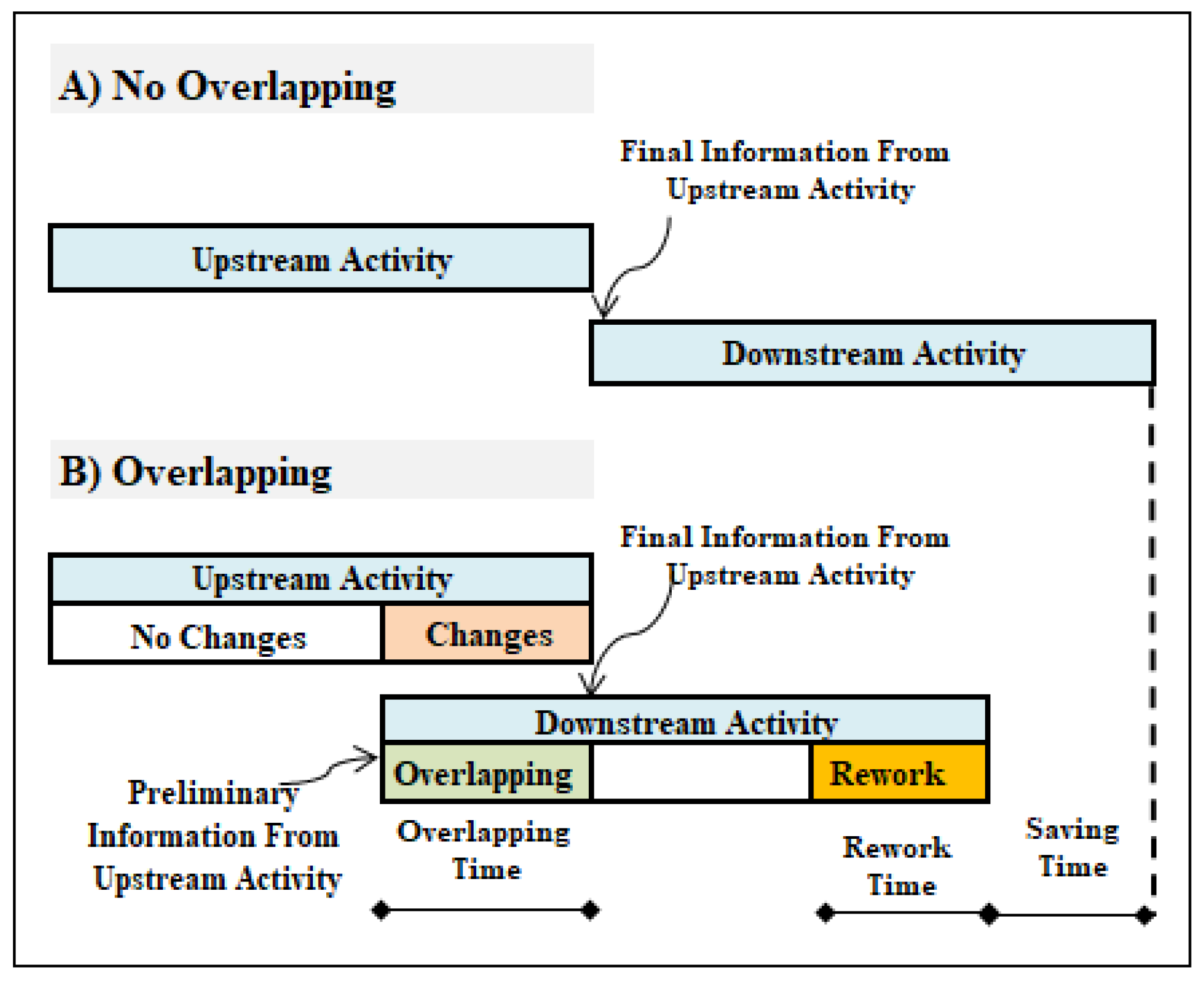
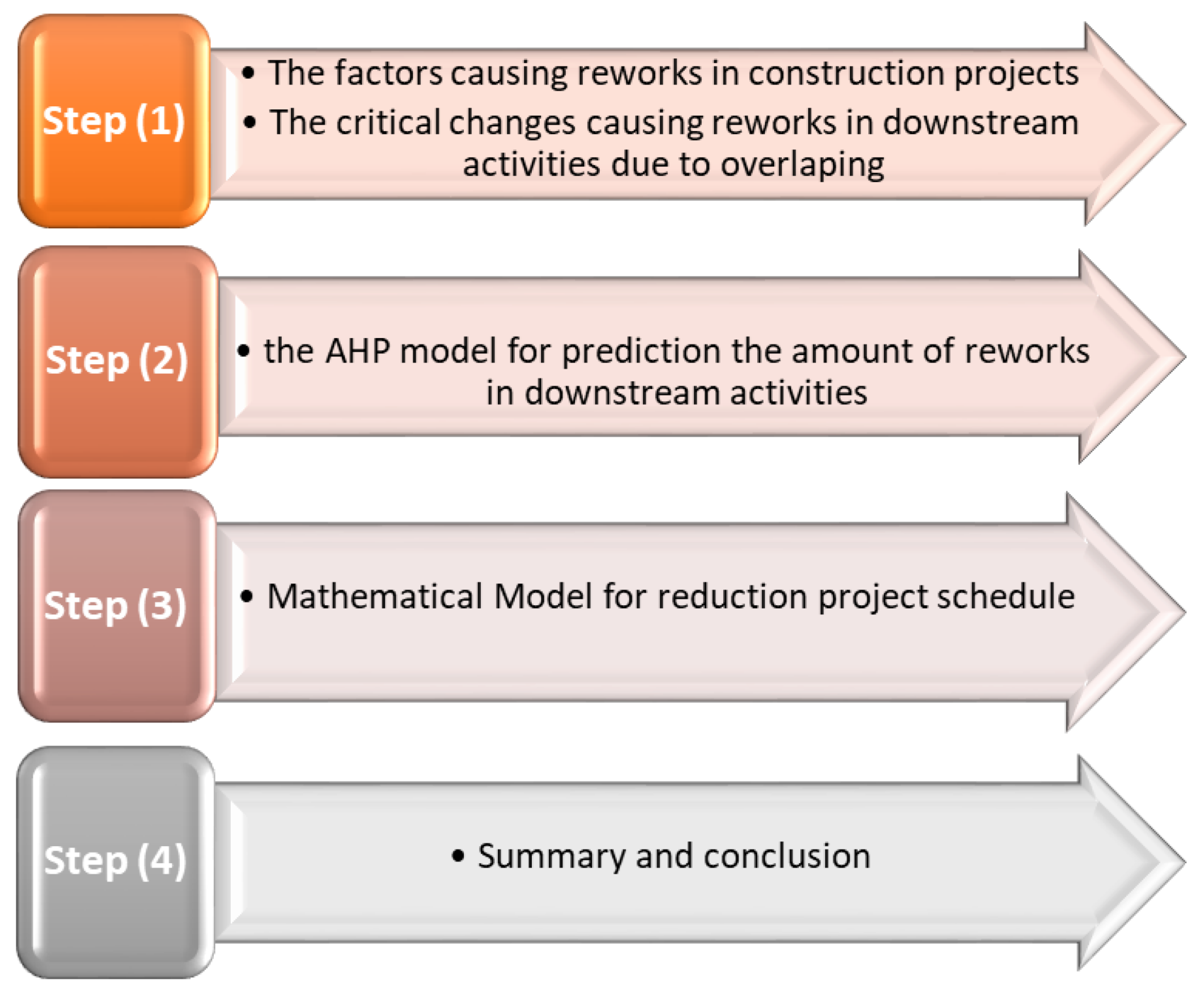
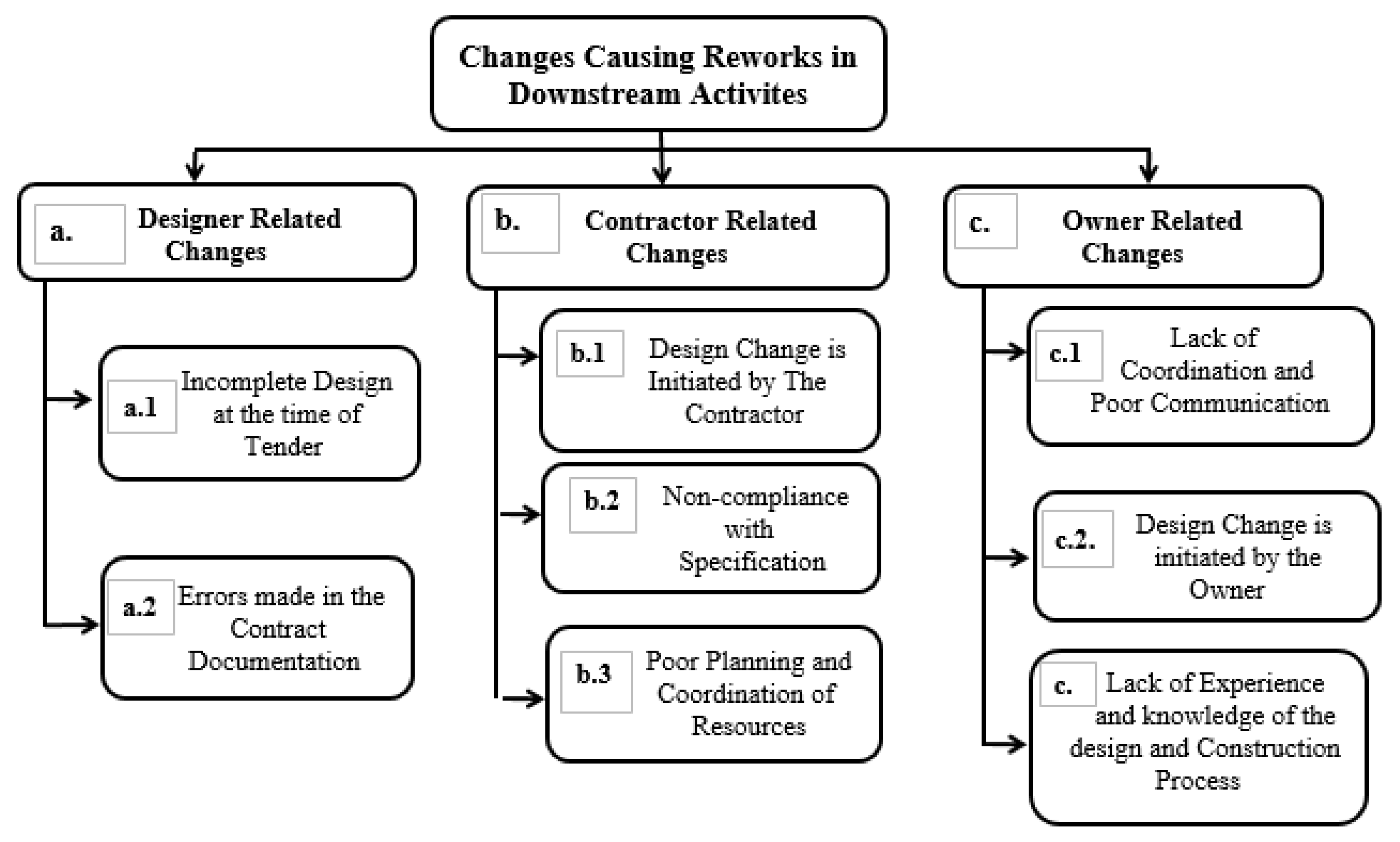
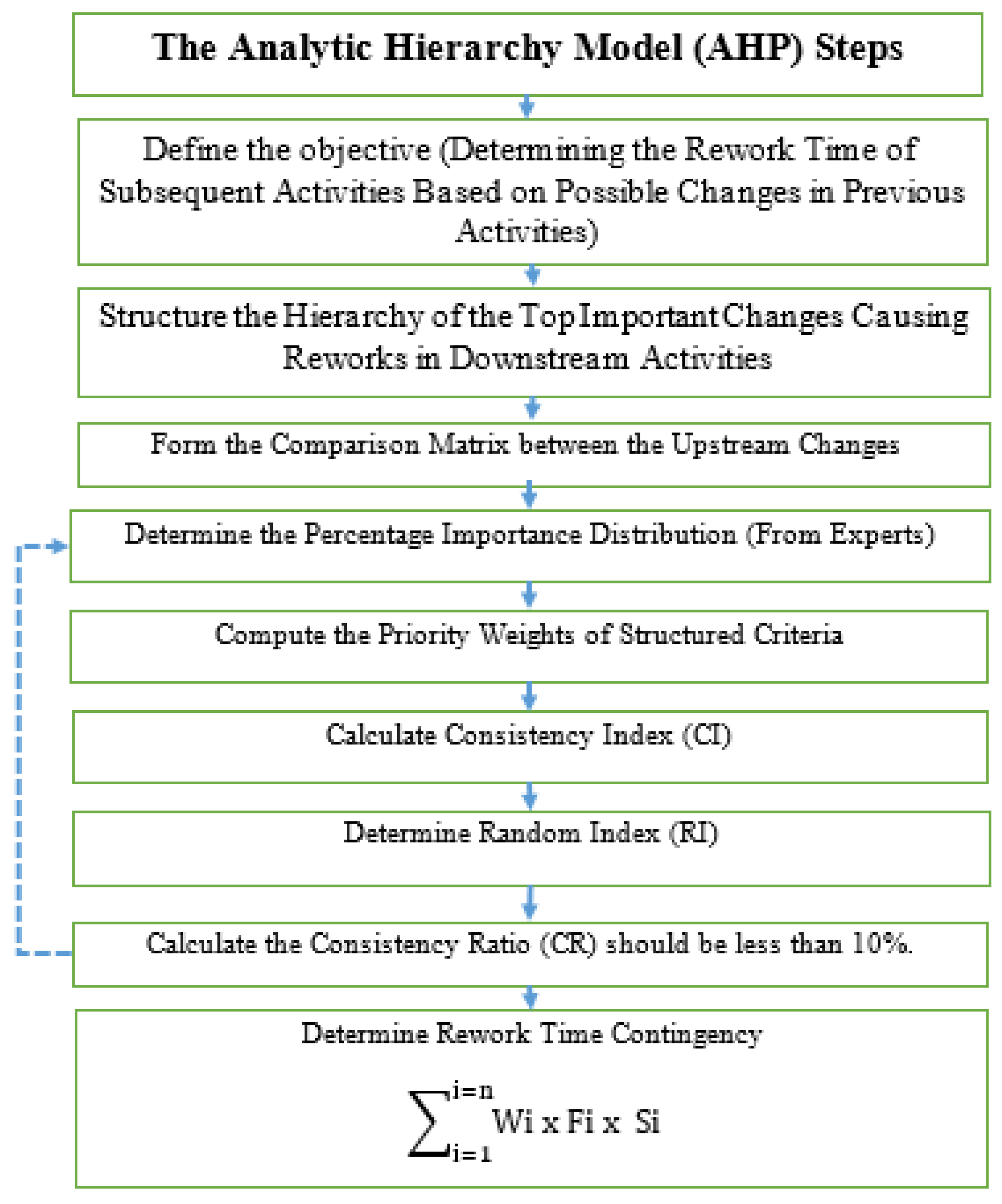
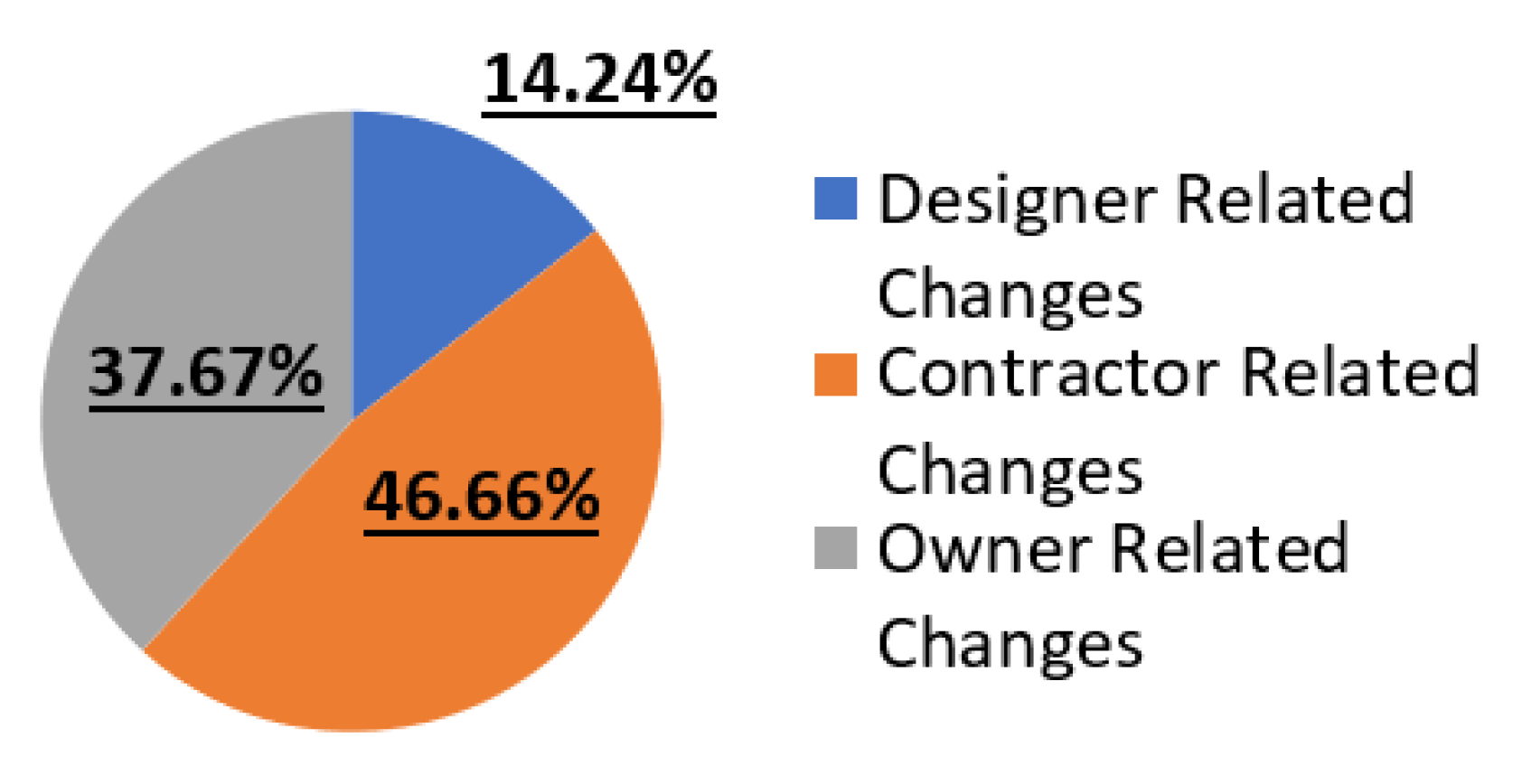





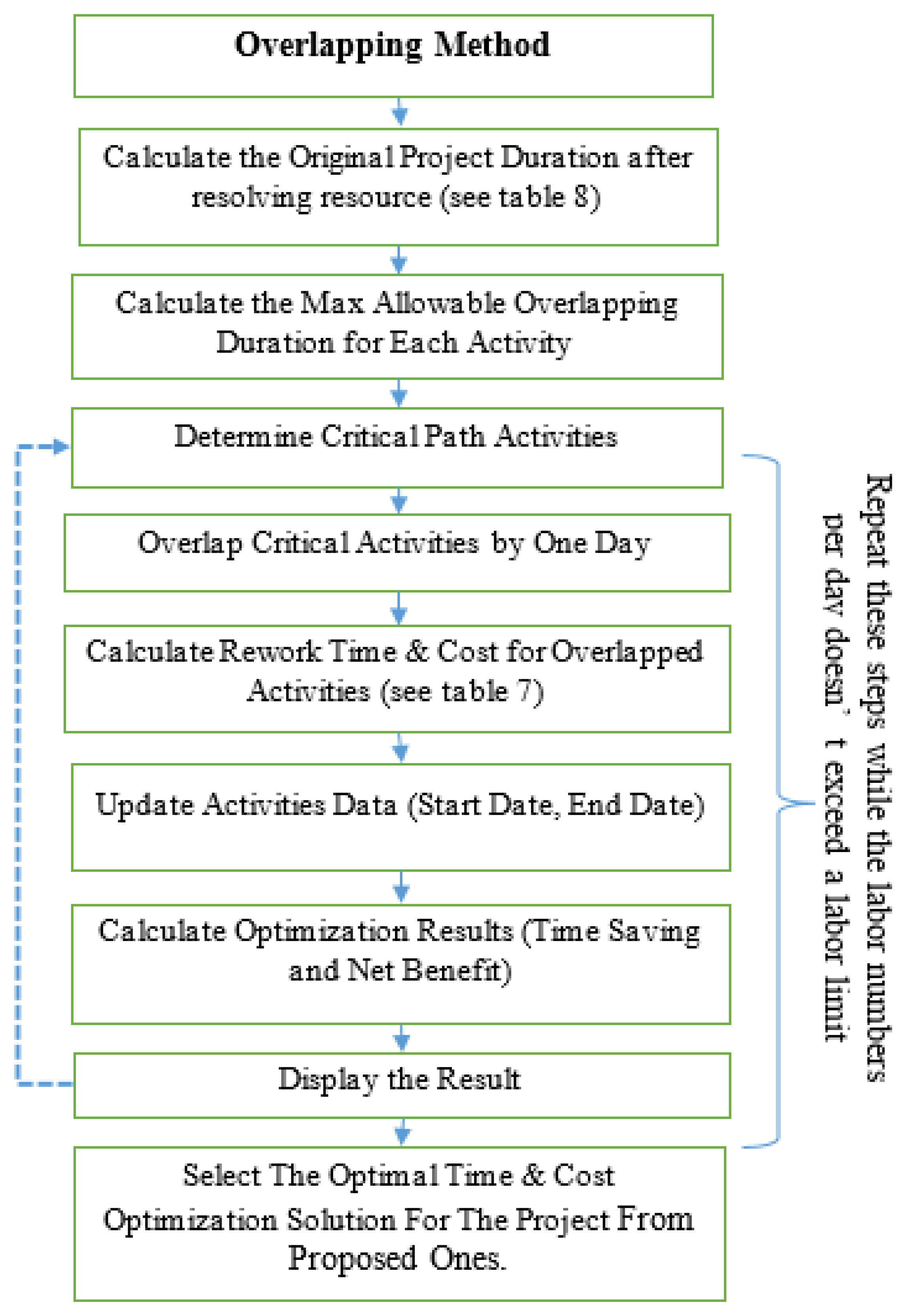
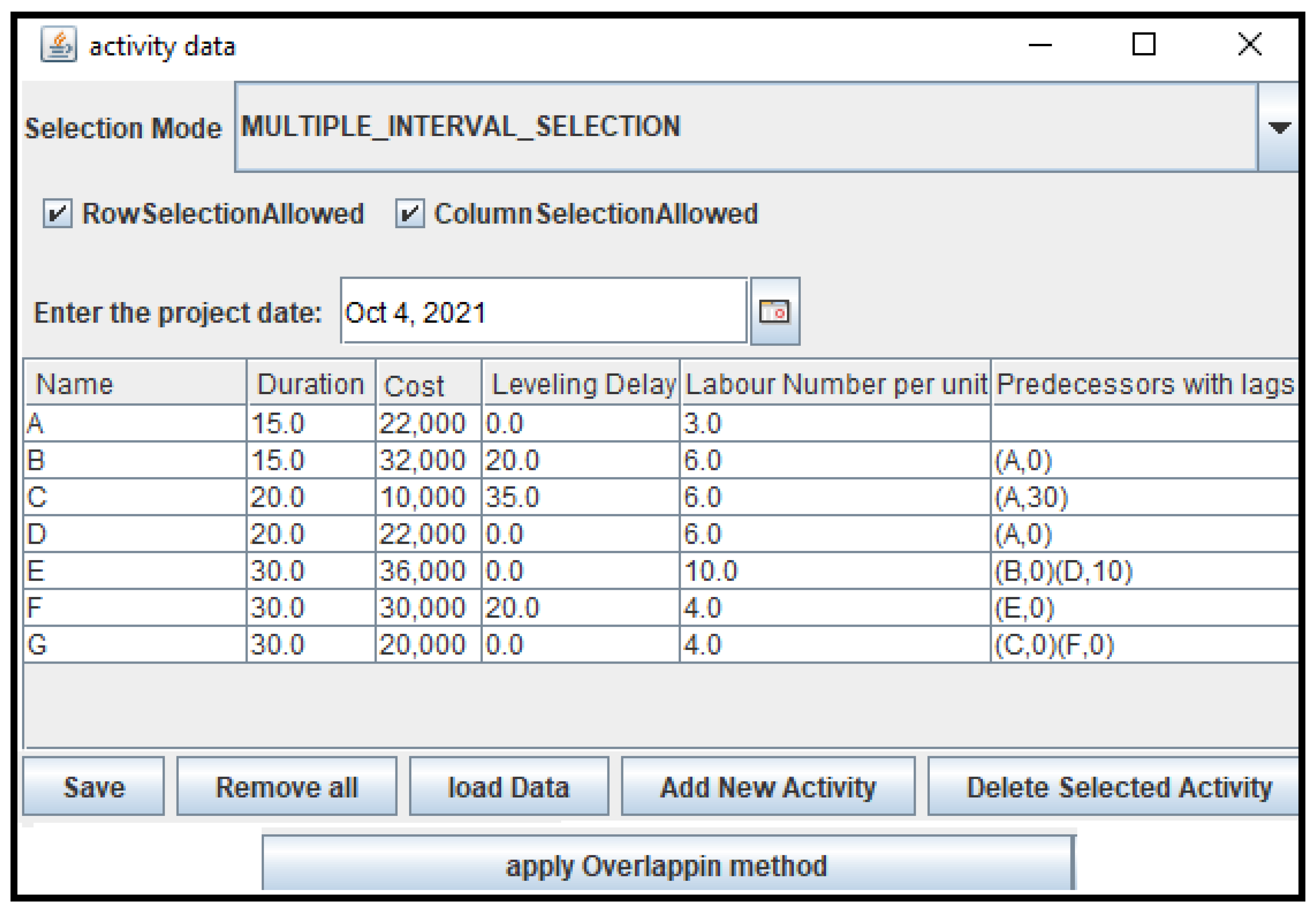


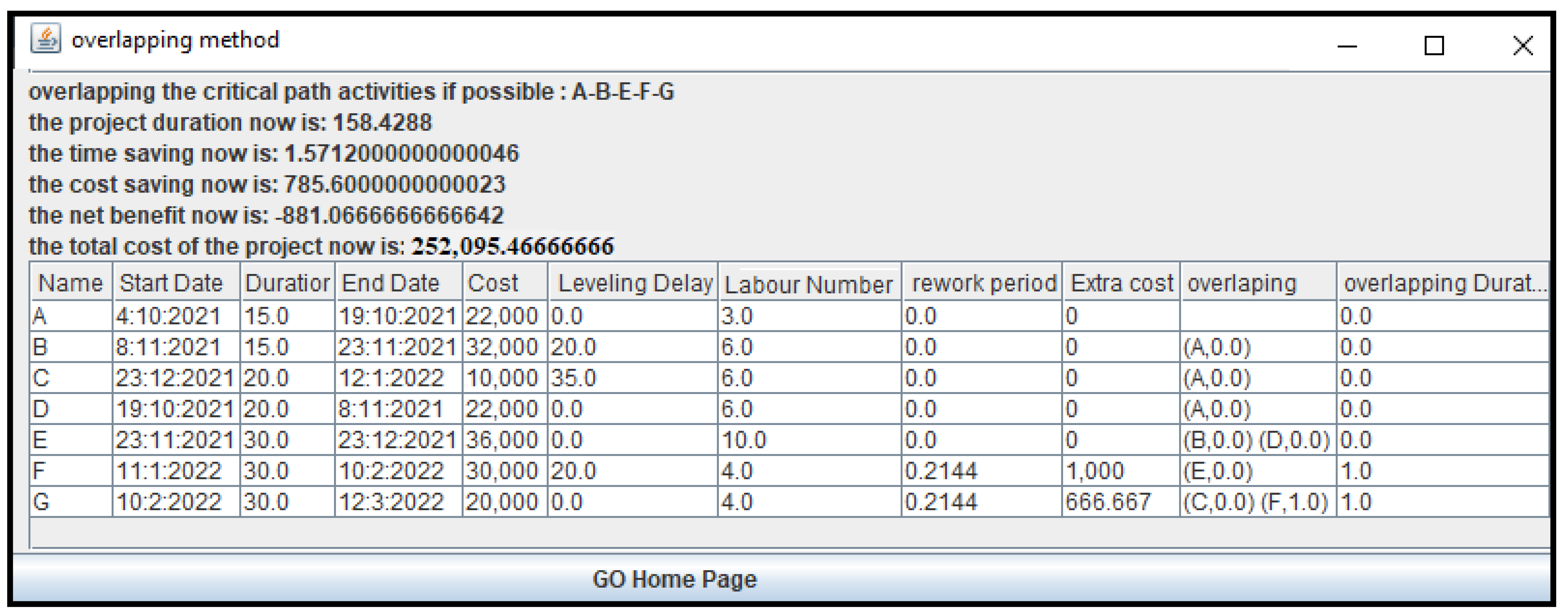

| Criteria | Criteria Weight | Sub-Criteria | Sub-Criteria Weight | Relative Weight (Wi) | Frequency (Fi) | Severity (Si) | Rework Time Contingency (R t c) |
|---|---|---|---|---|---|---|---|
| Designer | 0.14240 | Incomplete design at the time of the tender | 0.4177 | 0.0595 | 0.444 | 0.486 | 0.0128 |
| Errors made in the contract documentation | 0.5680 | 0.0809 | 0.405 | 0.517 | 0.0169 | ||
| Contractor | 0.46657 | Design change initiated by the contractor | 0.2296 | 0.1071 | 0.345 | 0.442 | 0.0163 |
| Non-compliance with specification | 0.3763 | 0.1756 | 0.463 | 0.515 | 0.0419 | ||
| Poor planning and coordination of resources | 0.3798 | 0.1772 | 0.368 | 0.576 | 0.0376 | ||
| Owner | 0.37674 | Lack of coordination and poor communication | 0.2131 | 0.0803 | 0.514 | 0.659 | 0.0272 |
| Design change initiated by the owner | 0.3808 | 0.1435 | 0.419 | 0.517 | 0.0311 | ||
| Lack of experience and knowledge of the design and construction process | 0.3918 | 0.1476 | 0.417 | 0.497 | 0.0306 | ||
| Rework time contingency (C) = ∑Wi × Fi × Si. | 0.2144 | ||||||
| Changes Category | Total Weight | Priority Victor | Rank | |
|---|---|---|---|---|
| a | Designer-related changes | 9.9682 | 0.1424 | 3 |
| b | Contractor-related changes | 32.6599 | 0.4666 | 1 |
| c | Owner-related changes | 26.3719 | 0.3767 | 2 |
| a | Designer-Related Changes | |||
| a.1 | Incomplete design at the time of the tender | 29.2407 | 0.4177 | 2 |
| a.2 | Errors made in the contract documentation | 39.7593 | 0.5680 | 1 |
| b | Contractor-Related Changes | |||
| b.1 | Design change initiated by the contractor | 16.0730 | 0.2296 | 3 |
| b.2 | Non-compliance with specifications | 26.3432 | 0.3763 | 2 |
| b.3 | Poor planning and coordination of resources | 26.5837 | 0.3798 | 1 |
| c | Owner-Related Changes | |||
| c.1 | Lack of coordination and poor communication | 14.9159 | 0.2131 | 3 |
| c.2 | Design change initiated by the owner | 26.6591 | 0.3808 | 2 |
| c.3 | Lack of experience and knowledge of the design and construction process | 27.4250 | 0.3918 | 1 |
| Project No. | Project Description | Changes in Upstream Activities | Target Total Time (Days) | Actual Total Time (Days) | Actual Time Rework Contingency (Time Saving/Target Time) |
|---|---|---|---|---|---|
| 1 | Primary school (Aswan) | Removal of damaged items, installation of new items, and maintenance of some damaged items | 300 | 210 | 0.30 |
| 2 | A multi-story building (Suez) | Modifications from the owner at the Hall of Conferences; several design changes introduced by the owner in a lot of items | 480 | 400 | 0.17 |
| 3 | Construction of building in 10th Ramadan City | Low experience for certain activities to be constructed and teamwork not qualified | 900 | 540 | 0.400 |
| 4 | Construction of building in 10th Ramadan City | Lack of coordination, poor communication, and design change initiated by the contractor | 135 | 120 | 0.11 |
| 5 | Construction of governmental garage in Cairo | Change in the area of the garage by the owner from 200 × 100 m2 to 200 × 150 m2 and addition of inspection rooms | 420 | 310 | 0.26 |
| Average actual time rework consistency | 0.247936508 | ||||
| Factor No. | Changes in Upstream Activities That Caused Time Rework in Downstream Activities | Relative Weight (Wi) | Project 1 | ||
|---|---|---|---|---|---|
| Frequency (Fi) % | Severity (Si) % | Estimated Rework Time Contingency | |||
| F1 | Incomplete design at the time of the tender | 0.059484936 | 0.7 | 0.4 | 0.0167 |
| F2 | Errors made in the contract documentation | 0.080883328 | 0.8 | 0.5 | 0.0324 |
| F3 | Design change initiated by the contractor | 0.107131275 | 0.5 | 0.7 | 0.0375 |
| F4 | Non-compliance with specifications | 0.17558497 | 0.4 | 0.5 | 0.0351 |
| F5 | Poor planning and coordination of resources | 0.177188089 | 0.55 | 0.3 | 0.0292 |
| F6 | Lack of coordination and poor communication | 0.080277663 | 0.4 | 0.4 | 0.0128 |
| F7 | Design change initiated by the owner | 0.143480008 | 0.8 | 0.5 | 0.0574 |
| F8 | Lack of experience and knowledge of the design and construction process | 0.147602383 | 0.5 | 0.7 | 0.0517 |
| Estimated rework time contingency for project 1 = ∑Wi × Fi × Si | 0.2728 | ||||
| No. | Project Description | Changes in Upstream Activities | Target Total Time (Days) | Actual Total Time (Days) | Actual Time Rework Contingency (Time Saving/Target Time) | Estimated Time Rework Contingency (from Model) | % Error (E-A)/A | % Absolute |
|---|---|---|---|---|---|---|---|---|
| 1 | Primary school (Aswan) | Removal of damaged items, installation of new items, and maintenance of some damaged items | 300 | 210 | 0.300 | 0.2728 | −0.091 | 9.082 |
| 2 | Residential building (Suez) | Modifications from the owner at the Hall of Conferences; several design changes introduced by the owner in a lot of items | 480 | 400 | 0.167 | 0.1870 | 0.1222 | 12.2211 |
| 3 | Construction of building in 10th Ramadan City | Low experience for certain activities to be constructed and teamwork not qualified | 900 | 540 | 0.400 | 0.4475 | 0.119 | 11.863 |
| 4 | Construction of building in 10th Ramadan City | Lack of coordination, poor communication, and design change initiated by the contractor | 135 | 120 | 0.111 | 0.0955 | −0.14 | 14.04 |
| 5 | Construction of governmental garage in Cairo | Change in the area of the garage from 200 × 100 m2 to 200 × 150 m2 and addition of inspection rooms | 420 | 310 | 0.262 | 0.2855 | 0.09 | 9.00 |
| ID | Activity Name | Activity Description | Predecessors | Duration (Days) | Lag | Cost (EGP) |
|---|---|---|---|---|---|---|
| 1 | A | Mobilization works | …… | 15 | 22,000 | |
| 2 | B | Supply of materials | A | 15 | 32,000 | |
| 3 | C | Supply of carpentry and electrical works | A | 20 | 30 with A | 10,000 |
| 4 | D | Excavation works | A | 20 | 22,000 | |
| 5 | E | Placing the concrete footing | B, D | 30 | 10 with D | 36,000 |
| 6 | F | Placing the concrete columns | E | 30 | 30,000 | |
| 7 | G | Wall works | C, F | 30 | 20,000 |
| ID | Downstream Activity | Upstream Activities | Overlapping Activities | Max. Overlapping Downstream | Effect of the Upstream Changes on the Upstream Activity Due to 1-Day Overlapping | |
|---|---|---|---|---|---|---|
| Time Rework | Cost Slope (Rework Cost) | |||||
| 1 | A | …… | ……… | ……. | ……. | ……. |
| 2 | B | A | OL (A, B) | 15 | 0.2144 | 686.0714 |
| 3 | C | A | OL (A, C) | 15 | 0.2144 | 214.3973 |
| 4 | D | A | OL (A, D) | 15 | 0.2144 | 471.6741 |
| 5 | E | B | OL (E, B) | 15 | 0.2144 | 771.8303 |
| D | OL (E, D) | 20 | 0.2144 | 771.8303 | ||
| 6 | F | E | OL (E, F) | 30 | 0.2144 | 643.1919 |
| 7 | G | C | OL (G, C) | 20 | 0.2144 | 428.7946 |
| F | OL (G, F) | 30 | 0.2144 | 428.7946 | ||
Publisher’s Note: MDPI stays neutral with regard to jurisdictional claims in published maps and institutional affiliations. |
© 2021 by the authors. Licensee MDPI, Basel, Switzerland. This article is an open access article distributed under the terms and conditions of the Creative Commons Attribution (CC BY) license (https://creativecommons.org/licenses/by/4.0/).
Share and Cite
Mohamed, H.H.; Ibrahim, A.H.; Soliman, A.A. Toward Reducing Construction Project Delivery Time under Limited Resources. Sustainability 2021, 13, 11035. https://doi.org/10.3390/su131911035
Mohamed HH, Ibrahim AH, Soliman AA. Toward Reducing Construction Project Delivery Time under Limited Resources. Sustainability. 2021; 13(19):11035. https://doi.org/10.3390/su131911035
Chicago/Turabian StyleMohamed, Hossam H., Ahmed H. Ibrahim, and Asmaa A. Soliman. 2021. "Toward Reducing Construction Project Delivery Time under Limited Resources" Sustainability 13, no. 19: 11035. https://doi.org/10.3390/su131911035
APA StyleMohamed, H. H., Ibrahim, A. H., & Soliman, A. A. (2021). Toward Reducing Construction Project Delivery Time under Limited Resources. Sustainability, 13(19), 11035. https://doi.org/10.3390/su131911035






